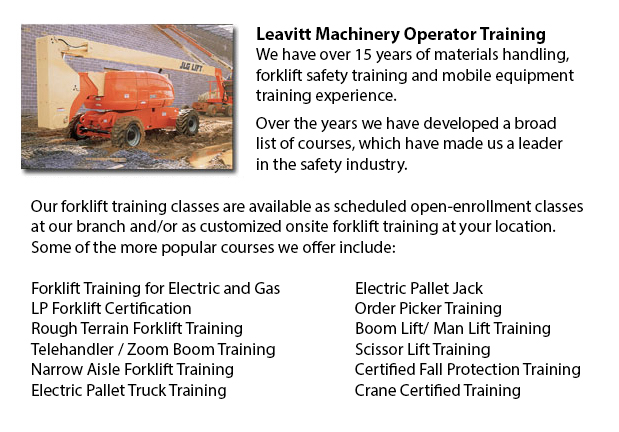
Kitchener Aerial Boom Lift Training - Aerial Boom Lift Training is required for anyone who supervises, operates or works in the vicinity of boom lifts. This type of aerial lift or aerial work platform is utilized for lifting people, materials and tools in projects requiring a long reach. They are usually used to access other above ground job-sites and utility lines. There are different types of aerial booms lifts, like cherry pickers, articulating boom lifts and extension boom lifts. There are two types of boom lift: "telescopic" and "knuckle".
Boom lift training is essential and typically involves the essential operations, equipment and safety problems. Employees are required whilst working with mobile equipment to understand the safe work practices, rules and dangers. Training program materials offer an introduction to the terminology, uses, concepts and skills required for employees to acquire competence in operating boom lifts. The material is aimed at workers, equipment operators and safety experts.
For your business needs, this training is educational, adaptive and cost-effective and will help your workplace become safer and more effective, allowing for higher levels of production. Fewer workplace accidents take place in workplaces with stringent safety policies. All equipment operators have to be trained and evaluated. They require knowledge of existing safety measures. They should understand and adhere to guidelines set forth by the local governing authorities and their employer.
It is the employer's responsibility to make certain that employees who should utilize boom lifts are trained in their safe use. Every different type of workplace machine needs its own machine operator certification. Certifications are available for aerial work platforms, articulating booms, industrial forklift trucks, scissor lifts, etc. Fully trained workers work more effectively and efficiently compared to untrained employees, who need more supervision. Right instruction and training saves resources in the long run.
The best prevention for workplace fatalities is correct training. Training can help prevent electrocutions, falls and collapses or tip overs. Aside from acquiring the required training, workplace accidents could be better prevented by utilizing the aerial work platforms based on the manufacturer's instructions. Allow for the combined weight of the worker, tools and materials when following load restrictions. Never override mechanical, electrical or hydraulic safety devices. Employees should be securely held in the basket using a body harness or restraining belt with a lanyard attached. Do not move lift equipment while workers are on the elevated platform. Employees should be careful not to position themselves between the basket rails and beams or joists in order to avoid being crushed. Energized overhead power lines should be at least 10 feet away from the lift equipment. It is recommended that workers always assume power lines and wires may be energized, even if they appear to be insulated or are down. Set the brakes and use wheel chocks if working on an incline.
-
Kitchener Forklift Training Schools
Kitchener Forklift Training Schools - The Advantages Of Taking One Of Our Forklift Training Schools Are you searching for work as a driver of a forklift? Our regulatory-compliant mobile equipment operator training offers instruction in types of fo... More -
Kitchener Overhead Crane Operator Training
Kitchener Overhead Crane Operator Training - Our overhead crane operator training course is designed to teach employees the basics of overhead crane/sling operation and pre-shift checks. Courses are taught by our expert trainers and consultants. Well... More -
Kitchener Crane Training School
Kitchener Crane Training School - The crane training school offers industry-relevant programs. Courses provide trainees with learning outcomes which match present industry demands. Our small class sizes combine hands-on experience and theory. Our qua... More -
Kitchener Skid Steer Ticket
Kitchener Skid Steer Ticket - The lift arms on the skid-steer loader are located at the side of the driver along with pivots behind the driver's shoulders. These features makes the skid-steer loader different as opposed to the conventional front load... More -
Kitchener Manlift Operator Certification
Kitchener Manlift Operator Certification - Our scissor platform and aerial lift training and certification empowers participants with a knowledge and general understanding of the efficient and safe use of "Power Operated Mobile Work Platforms," under... More -
Kitchener Crane Safety Training
Kitchener Crane Safety Training - Companies and crane operators have to be aware of the problems related to crane safety. Legislation provides rules for the safe operation, inspection and maintenance of lifting machines all around North America. Cran... More -
Kitchener Forklift Training Programs
Kitchener Forklift Training Programs - Are you searching for work as a forklift driver? Our regulatory-compliant mobile equipment operator training offers instruction in kinds of forklifts, pre-shift check, fuel kinds and dealing with fuels, and safe... More -
Telehandler Training in Kitchener
Telescopic handlers often known as telehandlers for short, are an extremely popular piece of heavy construction machinery. They are commonly used in the construction and agricultural industries. These equipments have extreme reaching ability and can... More

Forklift Certification Kitchener
TOLL FREE: 1-888-254-6157
Kitchener, Ontario
forkliftcertificationkitchener.com
Email Us
About Us


